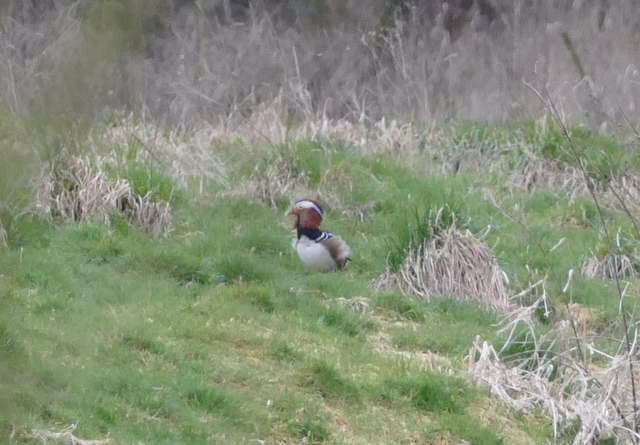Day 3, the final day of a long weekend of tours today – and the second day down in the Brecks. The weather forecast was bad – and for once, unfortunately, they got it right! But that didn’t stop us from getting out and, as usual, it didn’t stop us from seeing some really good birds.
We started at Santon Downham. We walked over the bridge and heading off alongside the river. A Grey Wagtail flew from some overhanging branches on the other side, past us upstream. A Yellowhammer was singing in the trees. A Chiffchaff nearby was doing just the same – they have arrived in force now. A pair of Great Spotted Woodpeckers were chasing each other round on the other side of the river, calling.
A croaking call from along the river alerted us to a single Mandarin flying past. It circled round and landed on the water. When we looked closer, we could see there were three of them on the river, two ducks and a smart drake. They clambered up onto the bank.
The Mandarins were constantly backwards and forwards over the next hour – flying up and down the river and landing high up in the trees (they are naturally a tree hole nester after all). It was hard to tell how many there were exactly.
 Mandarin – a female perched high up in the trees
Mandarin – a female perched high up in the trees
It was forecast to start raining at 10am, so we hoped to have a window of dry weather in the morning. Unfortunately the rain arrived an hour early. It wasn’t raining really hard, but it was persistent. At least the wind hadn’t picked up yet.
We stood in the shelter of the trees and listened. Not surprisingly in the cold and wet, activity was subdued. A Great Spotted Woodpecker drummed sporadically, a Green Woodpecker called occasionally, but that was it. We had hoped to find the Lesser Spotted Woodpecker here, but it was probably away in the pines and birches feeding. It was not the weather for it to be drumming. Getting quite damp by this stage, we decided to head back. A Brambling sang its wheezy song from the trees along the river. A flock of Redwing flew ahead of us. A Marsh Tit called from the bushes.
Lynford Arboretum seemed like a good place to head for, with the chance of birding amongst the trees out of the worst of the weather. By the time we got round there, the rain had eased off. We walked up to the gate and stopped to look through the Chaffinches feeding on the ground. Almost immediately, we picked up a Hawfinch which flew down and landed amongst the leaves further back, a female. We got it in the scope and got great views as it fed unobtrusively, admiring its massive bill.
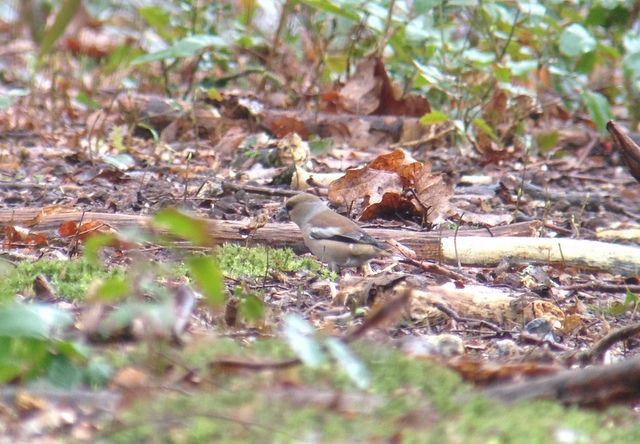
 Hawfinch – this female fed quietly on the ground
Hawfinch – this female fed quietly on the ground
She flew up into the trees, calling, but returned a short while later. We could hear a male Hawfinch as well, singing up above, but we couldn’t find it amongst the branches. At one point, both birds flew off into the Arboretum, and perched up in one of the trees, but they flew back almost immediately. The two Hawfinches then perched up in a bush amongst the trees, the male singing and the female feeding quietly on buds. Then they flew off again and we decided to move on.
We could already hear a Firecrest singing from the trees behind us. We followed the noise and found the bird amongst the fir trees, in much the same place as we had seen it yesterday. But this time, it was perched lower down and came out in full view on some bare branches. Stunning. It got agitated and began to chase a second bird all round through the trees – presumably another Firecrest. Eventually, it gave up and returned to its favoured trees, still singing. Great views.
We wanted to explore the woodland walk, but it was very quiet in the trees today, apart from the odd Marsh Tit. Perhaps not a surprise, it was still cold and damp. We did pause to admire the Dog Violets in flower along the edges of the path. But we figured it might be a better idea to try something else, so we headed back to the car.
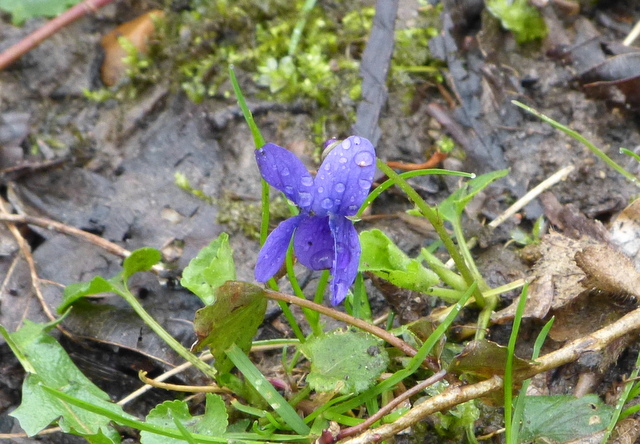 Dog Violet – lots were in flower alongside the path
Dog Violet – lots were in flower alongside the path
We drove up to an area favoured by the Stone Curlews, but on our way there the rain started again and the wind began to pick up. We had a quick look in the fields from the car but couldn’t see anything in any of the likely fields. So, while it was raining, we thought we might as well have an early lunch. The chances of seeing a Goshawk in wind and rain is minimal, but we headed over to a likely site – we thought we might as well try our luck while we were eating.
We watched from the comfort of the car over lunch. A couple of Red Kites circled lazily over the fields, buffeted by the wind. A Sparrowhawk rose briefly out of the wood before thinking better of it. A couple of Common Buzzards did attempt to circle up, but they didn’t get very high, and they spend most of their time down among the trees. That was about all we could realistically have hoped for so, once we had finished eating, we moved on again.
It had stopped raining once more, so we walked into the forest along a ride. A Marsh Tit sang from one side and we could hear lots of Long-tailed Tits on the other. Then we caught a snatch of a distinctive sibilant song from deep within the trees, a Willow Tit. It sang again and again, and eventually we worked out where it was, but before we could get a look it flew out and we lost track of it among the trees. We searched along the ride and found a nice little mixed flock of tits feeding in a sheltered corner – Coal Tits, Blue Tits, and Long-tailed Tit, plus Goldcrests, Treecreeper and a single Chiffchaff. While we were looking through them, the Willow Tit started calling nearby, a distinctive nasal scolding. We caught a couple of glimpses of it among the trees, and in flight, but it didn’t stay still long enough to get everyone onto it. It moved deeper in, so we reluctantly left it to it.
We headed back to have another more thorough look for the Stone Curlews. We had only just got out of the car and started scanning when we saw the rain coming yet again. This time it was falling in stair rods and heading straight for us across the fields, moving quickly on the strengthening wind. We made a beeline back to the car, just in time before it hit us. For five or ten minutes it absolutely lashed down and we couldn’t even see out of the windows. There was thunder and lightning – that wasn’t forecast – and the trees thrashed around in the wind. We sat in the warm and chatted.
We had positioned the car next to one of the Stone Curlews’ favoured fields, although they hadn’t been in there earlier. When the rain finally stopped, we had a casual glance out of the window and there was a Stone Curlew, on the edge of an old maize cover strip. We wound down the windows and realised there were actually three together, huddled down in the field.
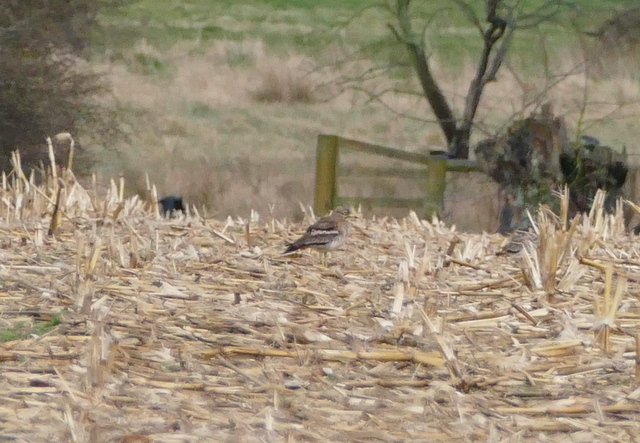 Stone Curlews – emerging after the rain
Stone Curlews – emerging after the rain
Then they started to move, shaking the rain off. Scanning across the strip, another two Stone Curlews appeared from the other side and similarly had a shake and a preen. The birds then all started to run around amongst the broken stems. They were remarkably well camouflaged in there, but we could see them as they moved. Some of the Stone Curlews even started to display, little bows, walking with their tails pointed into the air. We watched transfixed from the dry interior of the car.
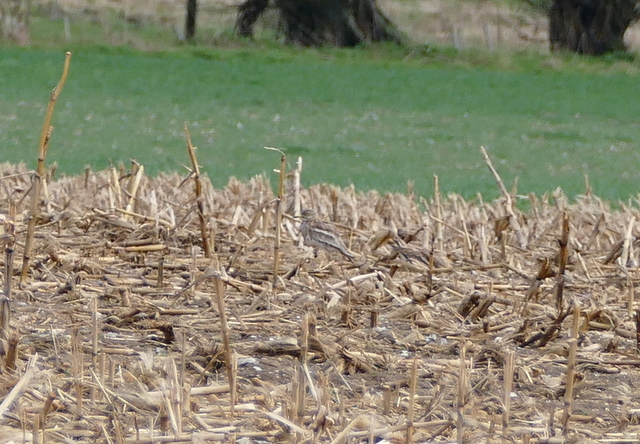 Stone Curlew – very well camouflaged in dead maize, as well as stones
Stone Curlew – very well camouflaged in dead maize, as well as stones
We headed back towards base, and with a little time still to play with, decided to have another look at the Great Grey Shrike. It was in its usual place, in the clearing, but spending more time huddled down in the lee of the rowed up tree stumps. A couple of Woodlarks flew round the clearing, singing and calling, and one perched up briefly on a stump.
 Great Grey Shrike – in its usual clearing
Great Grey Shrike – in its usual clearing
As the last of the rain blew through, the sky had brightened and there were now big patches of blue sky. Could it be enough to bring out a Goshawk? We returned to the site where we had seen the young male yesterday to chance our luck. We had only just arrived and stopped to look at a couple of Common Buzzards swooping around distantly above some trees when a third bird appeared. It was a little smaller than the Buzzards, but it was still immediately obvious that it was a big and powerful beast. It was the young male Goshawk again. Unfortunately it drifted away from us, through the tree tops, and two Carrion Crows then decided to have a go at it (they were a little smaller than it was – a good size comparison). They chased the Goshawk off even further away, and we could just see it distantly as it circled up a little and then swept down into the trees.
We stood and waited a little, watching to see if it would reappear, like it had done yesterday. Unfortunately it didn’t. Although there was now brightness and some sunshine amongst the clouds, it was very windy (gusting up to 56 mph, checking the Met Office later). We had trouble standing upright, let alone stopping our scopes from being blown over. Perhaps it was no surprise that the Goshawk had disappeared into the trees, and we counted ourselves lucky to have seen it at all under the circumstances – and lucky to have seen as many birds as we had through the day, given all the adverse weather.
